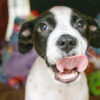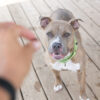Living with a pet can be beneficial to children. Pets can enhance a child’s self-esteem, teach them responsibility and help them to learn empathy. However, children and dogs are not always going to automatically start off with a wonderful relationship. Parents must be willing to teach the dog and the child acceptable limits of behavior in order to make their interactions pleasant and safe.
Selecting a Dog
What age is best? Many people have a “warm fuzzy” image of a puppy and a child growing up together. If you have a young child and are thinking of adopting a puppy (less than one year old) there are a few things you need to consider.
- Time and energy: Puppies require a lot of time, patience, training, and supervision. They also require socialization to become well adjusted adult dogs. This means they need to be taken places and exposed to new things and new people. If you have a young child who already requires a lot of care and time, will you have enough time to care for a puppy, as well?
- Safety: Puppies, because they’re babies, are somewhat fragile creatures. A puppy may become frightened, or even injured, by a well-meaning, curious child who wants to constantly pick him up, hug him or explore his body by pulling on his tail or ears.
- Rough play: Puppies have sharp teeth and claws with which they may inadvertently injure a small child. Puppies also tend to jump up on small children and knock them down. All interactions between your child and puppy will need to be closely supervised to minimize the chances of either being injured.
- Advantages of getting an adult dog: Adult dogs require less time and attention once they’ve adjusted to your family and household routine, although you’ll still need to spend time helping your new dog with the transition to his new home. You can better gauge how hardy and tolerant an adult dog will be of childish enthusiasm, and you can work with your local animal shelter to adopt a dog with a history of getting along well with children. As a general guideline, if your child is under six years old, it may be best to adopt a dog that’s over two years old. Although puppies can be a lot of fun, and it’s exciting and rewarding to help them grow into wonderful companions, they do require significantly more time to train and supervise than an adult dog.
What breed is best? Although some general statements can be made about specific dog breeds, the characteristics of an individual dog are just as important as a dog’s breed.
- Size: Small breeds of dogs, such as toy or miniature poodles, Chihuahuas or Cocker Spaniels, may not be good choices for a young child. These small breed dogs are more easily injured than larger dogs and may be more easily frightened by a lot of activity, loud noises and by being picked up and fondled frequently. Frightened dogs tend to snap or bite in order to protect themselves. Larger dogs may be better able to tolerate the activity, noise and rough play that is an inevitable part of living with children.
- Breed type: Some of the sporting breeds, such as Labradors and golden retrievers, make good pets for families with children. Breeds that have been selected for protective behavior, such as chows and Rottweilers, may not be as good for families with children. It’s sometimes difficult for this type of dog to comfortably tolerate the many comings and goings of children and their friends, who may be perceived as territorial intruders. Herding breeds are inclined to “herd” children, chasing and nipping at their heels.
Who Will Care For The Dog?
It’s unrealistic to expect a child, regardless of age, to have sole responsibility for caring for a dog. Not only do dogs need basic things like food, water, and shelter, they also need to be played with, exercised, and trained on a consistent basis. Teaching a dog the rules of the house and helping him become a good companion is too overwhelming a task for a young child. Responsible teenagers may be up to the task, but they may not be willing or able to spend an adequate amount of time with the dog, as their desire to be with their friends usually takes over at this age.
While it is great to teach children responsibility by having them assist with animal care tasks and training, you must still be prepared and willing to be the primary caretaker and ensure that the dog’s needs are being met.
Starting Off Right
Following are some guidelines to help you start off on the right foot. Remember, small children should never be left alone with a dog or puppy without adult supervision.
Holding
- It’s safest for both your child and puppy to have your child sit down whenever he wants to hold the puppy. Puppies are squirmy and wiggly and may easily fall out of a young child’s arms and be injured. If held insecurely, a puppy may become frightened and snap or scratch in response. After your child is sitting, you can place the puppy in his arms.
- Have your child offer the puppy a toy while he pets the puppy. When puppies are teething, they tend to chew on everything, including hands and arms, so having a toy handy will divert the puppy’s teeth away from your child. An added benefit is that the puppy will come to associate being held by your child with positive experiences.
- For larger dogs, have your child sit in your lap and let the dog approach both of you. This way you can control your child and not allow him to get “carried away” with pats that are too rough. You are also there to teach your new dog to treat your child gently.
Petting and giving affection
Children often want to hug dogs around the neck. Your dog may view this as a threatening gesture, rather than an affectionate one, and may react with a growl, snap, or bite. You should teach your child to pet your dog from underneath the dog’s chin, rather than hugging him or reaching over his head. Avoid letting your child pet the dog if the dog is stressed. You should also teach your child to avoid staring at, or looking directly into, your dog’s eyes. Never allow your child to tug on the dog’s tail or ears, or to grip the dog’s skin and fur during petting. Although it can look cute, never allow your child to sit on a dog.
Giving Treats
Children tend to become somewhat fearful and anxious when a dog tries to take a treat from their hand. This causes them to jerk their hand away at the last second. The dog may then jump up or lunge to get the treat which may result in the child being knocked down. Have your child place the treat in an open palm, rather than holding it in their fingers. You may want to place a hand underneath your child’s hand to help guide him. As an alternative, you can have your child toss treats for the dog. Be sure they gently toss them away from or next to the dog, and not at them.
Supervising Play
Children move with quick, jerky movements, have high-pitched voices and often run, rather than walk. All these behaviors somewhat resemble the behavior of prey animals. Most of a dog’s play behaviors are based on predatory behavior. Consequently, your dog may respond to your child’s behavior by chasing, nipping at their heels, jumping, or even trying to knock them down.
Your child will need to play quietly and calmly around your new dog until the dog becomes more comfortable and until the child understands how to respect and properly interact with the dog.
Your dog must learn that certain behaviors on his part are unacceptable, but he must also be taught what behaviors are the right ones. Our handout: “Dealing with Normal Puppy Behavior: Nipping” outlines procedures for discouraging rough play and encouraging appropriate play. Most children under the age of ten are not capable of carrying out these procedures, so it’s helpful to teach your dog a “leave it” cue that you can use when play gets too rough as well as a “drop it” cue so the dog will know to drop things that he’s not allowed to have. Taking an obedience class together is a good way to teach your dog cues and strengthen your relationship.
An approach that is not helpful is to punish your dog for his behavior. If he learns that being around children always results in “bad things” happening to him, he may become defensive in their presence.
Possessions
Your dog won’t know the difference between their toys and your child’s toys until you teach them.
- Your child must take responsibility for keeping their toys out of your dog’s reach.
- If you catch your dog chewing on something they should not have and they haven’t learned the “drop it” cue yet, get their attention by calling their name, making a kissing sound, or a soft clap, then trade them for an acceptable chew toy and praise lavishly when the dog takes the item that you want them to have.
- Don’t give your dog objects to play with such as old socks, old shoes or old children’s toys that closely resemble items that are off-limits. They can’t tell the difference!
- Dogs can be possessive about their food, toys, and space. Children need to learn to respect their dog and always give them plenty of space, especially when eating or engaging with an enrichment item. Failure to do this can cause your dog to develop resource guarding tendencies, it can add strain to the child and dog’s relationship and puts the safety of the child at risk
If your dog is growling or snapping at your child for any reason, the situation needs IMMEDIATE attention. Punishing your dog is likely to make matters worse. You may call our Behavior Helpline at 734-662-5545 for more information.








